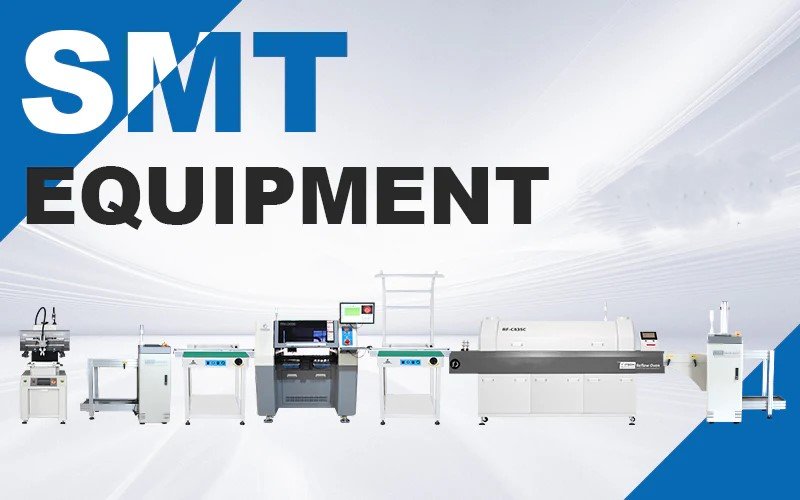Automation in Surface Mount Technology (SMT) equipment has significantly improved production efficiency, accuracy, and cost-effectiveness in electronics manufacturing. By integrating AI, robotics, and real-time monitoring, SMT lines can now handle higher production volumes, reduce errors, and streamline processes. Below are the key ways automation has enhanced SMT production efficiency.
1. Faster Component Placement with High-Speed Pick-and-Place Machines
Advancement:
- Modern pick-and-place machines use multi-head nozzles and vision-guided systems to place components at extremely high speeds.
- AI-driven optimization selects the most efficient placement sequence.
Efficiency Gains:
- Machines can place up to 100,000 components per hour (CPH).
- Reduces manual handling, minimizing errors.
- Ensures precise component alignment, reducing misplacement and rework costs.
2. Smart Solder Paste Printing with Automated Inspection
Advancement:
- Stencil printers with automatic alignment ensure accurate solder paste deposition.
- Integrated SPI (Solder Paste Inspection) detects print defects before PCB assembly.
Efficiency Gains:
- Reduces solder defects like bridging, insufficient paste, and misalignment.
- Minimizes waste and rework, improving first-pass yield.
- Enables high-speed, repeatable solder paste printing.
3. AI-Powered Automated Optical Inspection (AOI) and X-Ray Inspection (AXI)
Advancement:
- AOI machines use machine learning algorithms to detect component misalignment, solder defects, and missing parts.
- 3D X-ray inspection (AXI) scans hidden solder joints in BGAs, QFNs, and multilayer PCBs.
Efficiency Gains:
- Identifies defects in real-time, reducing faulty product output.
- Reduces manual inspection time, speeding up quality control.
- Improves defect classification, reducing false positives and unnecessary rework.
4. Automated Reflow Soldering with Smart Thermal Profiling
Advancement:
- Reflow ovens now use multi-zone heating with real-time temperature monitoring.
- AI-driven thermal profiling optimizes heating cycles for different PCB designs.
Efficiency Gains:
- Prevents cold solder joints and overheating, ensuring strong component bonding.
- Reduces energy consumption by optimizing heat distribution.
- Ensures consistent solder joint reliability, reducing field failures.
5. Intelligent Material Handling and Feeder Systems
Advancement:
- Smart component feeders with auto-calibration improve material tracking.
- Robotic conveyors and AGVs (Automated Guided Vehicles) transport PCBs seamlessly.
Efficiency Gains:
- Reduces downtime caused by manual material loading.
- Enables continuous, high-speed production without interruptions.
- Tracks component inventory in real-time, reducing stock shortages and delays.
6. Predictive Maintenance and IoT-Based Equipment Monitoring
Advancement:
- SMT machines now have IoT sensors that track machine wear and performance.
- AI-driven predictive maintenance alerts operators before failures occur.
Efficiency Gains:
- Reduces unexpected machine downtime, improving uptime.
- Lowers maintenance costs by replacing parts before failure rather than on a fixed schedule.
- Improves overall equipment effectiveness (OEE) for continuous production.
7. Full Line Integration with Industry 4.0 and Smart Factories
Advancement:
- SMT lines are now integrated into smart factory networks using MES (Manufacturing Execution Systems).
- Real-time data exchange between machines optimizes production flow.
Efficiency Gains:
- Enables remote monitoring and control of the entire SMT line.
- Reduces bottlenecks by dynamically adjusting machine speeds.
- Enhances traceability, ensuring defect tracking and better process control.
8. Automated Selective Soldering for Mixed-Technology PCBs
Advancement:
- Selective soldering machines automate through-hole component soldering in mixed SMT-THT assemblies.
- Uses programmable soldering paths for precise control.
Efficiency Gains:
- Eliminates manual soldering, improving consistency and reliability.
- Reduces thermal damage to sensitive SMT components.
- Enables automation in low-volume, high-mix production.
9. AI-Based Process Optimization for Minimal Defects
Advancement:
- AI-driven SMT software analyzes production data to optimize placement accuracy, soldering conditions, and material usage.
- Adaptive AI systems adjust machine settings dynamically for different PCB designs.
Efficiency Gains:
- Reduces waste and material costs by optimizing placement and soldering.
- Improves first-pass yield, lowering defect rates.
- Enhances production planning by predicting and preventing bottlenecks.
10. Automated PCB Depaneling and Conformal Coating
Advancement:
- Laser and router-based depaneling machines separate PCBs from panels without mechanical stress.
- Robotic conformal coating systems apply protective layers for harsh environments.
Efficiency Gains:
- Reduces PCB damage from manual cutting.
- Improves product durability and reliability, especially in automotive, aerospace, and medical applications.
- Ensures uniform protective coating application, minimizing defects.
Conclusion
Automation in SMT equipment has transformed electronics manufacturing by increasing production speed, accuracy, and quality while reducing costs, errors, and waste. Advanced AI-driven quality control, robotic material handling, predictive maintenance, and real-time data integration are enabling high-efficiency, smart manufacturing environments.
Hashtags
#SMTAutomation #SmartManufacturing #AutomatedAssembly #EfficientProduction #SurfaceMountTechnology #Industry40 #HigherEfficiency #PrecisionManufacturing #MassProduction #CostReduction #YieldImprovement #Scalability #AdvancedSMTEquipment #Robotics #PickAndPlaceAutomation #ReflowSoldering #AIinManufacturing #SMTInspection #MachineLearning #AutomatedQualityControl #IoTinManufacturing #SmartFactories #AIOptimization #PredictiveMaintenance #DigitalManufacturing #IndustrialRobotics #AutomotiveElectronics #MedicalDevices #ConsumerElectronics #AerospaceTechnology #WearableTech #PCBManufacturing














